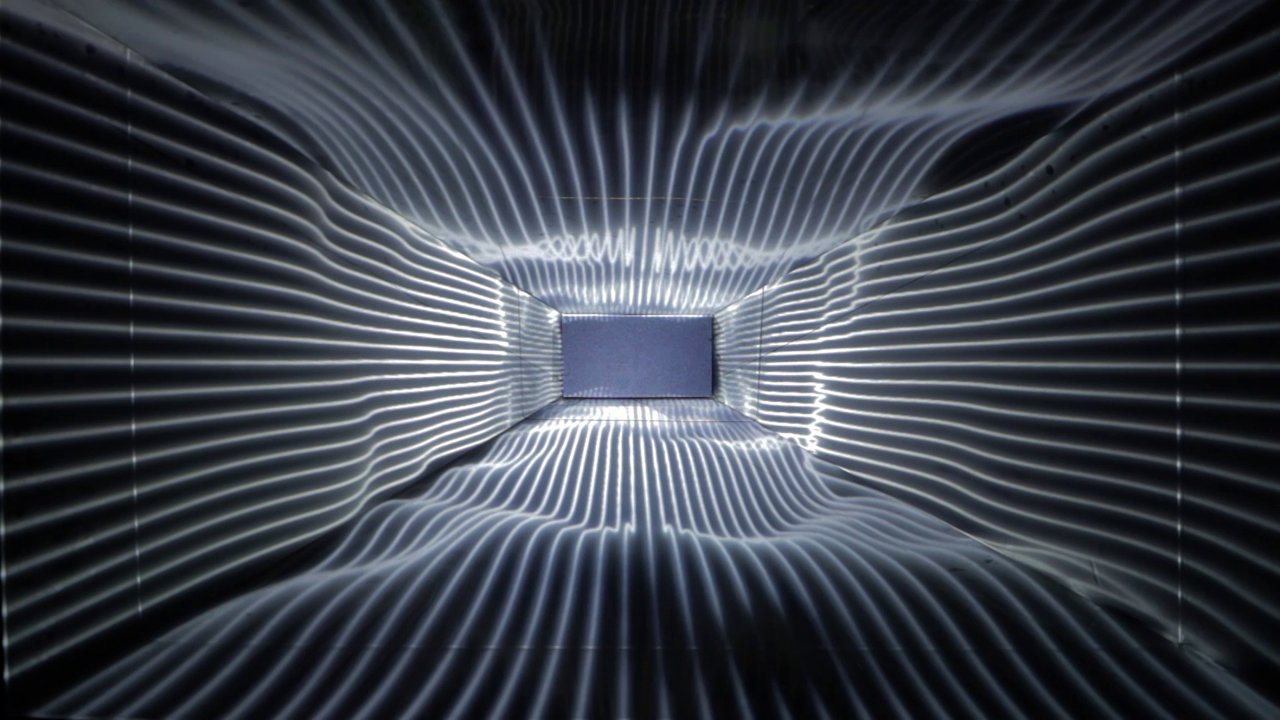


MIRROR CUBE
Sweden’s Tree Hotel
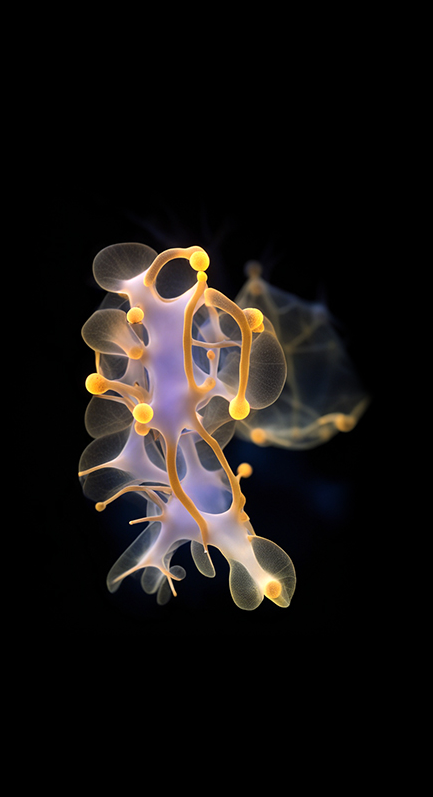
Memo Akten and Katie Peyton Hofstadter
Embodied Simulation
‘Embodied Simulation’ is a multiscreen video and sound installation that aims to provoke and nurture strong connections to the global ecosystems of which we are a part. The work combines artificial intelligence with dance and research from neuroscience to create an immersive, embodied experience, extending the viewer’s bodily perception beyond the skin, and into the environment.
The cognitive phenomenon of embodied simulation (an evolved and refined version of ‘mirror neurons’ theory) refers to the way we feel and embody the movement of others, as if they are happening in our own bodies. The brain of an observer unconsciously mirrors the movements of others, all the way through to the planning and simulating execution of the movements in their own body. This can even be seen in situations such as embodying and ‘feeling’ the movement of fabric blowing in the wind. As Vittorio Gallese writes, “By means of a shared neural state realized in two different bodies that nevertheless obey to the same functional rules, the ‘objectual other’ becomes ‘another self’.”
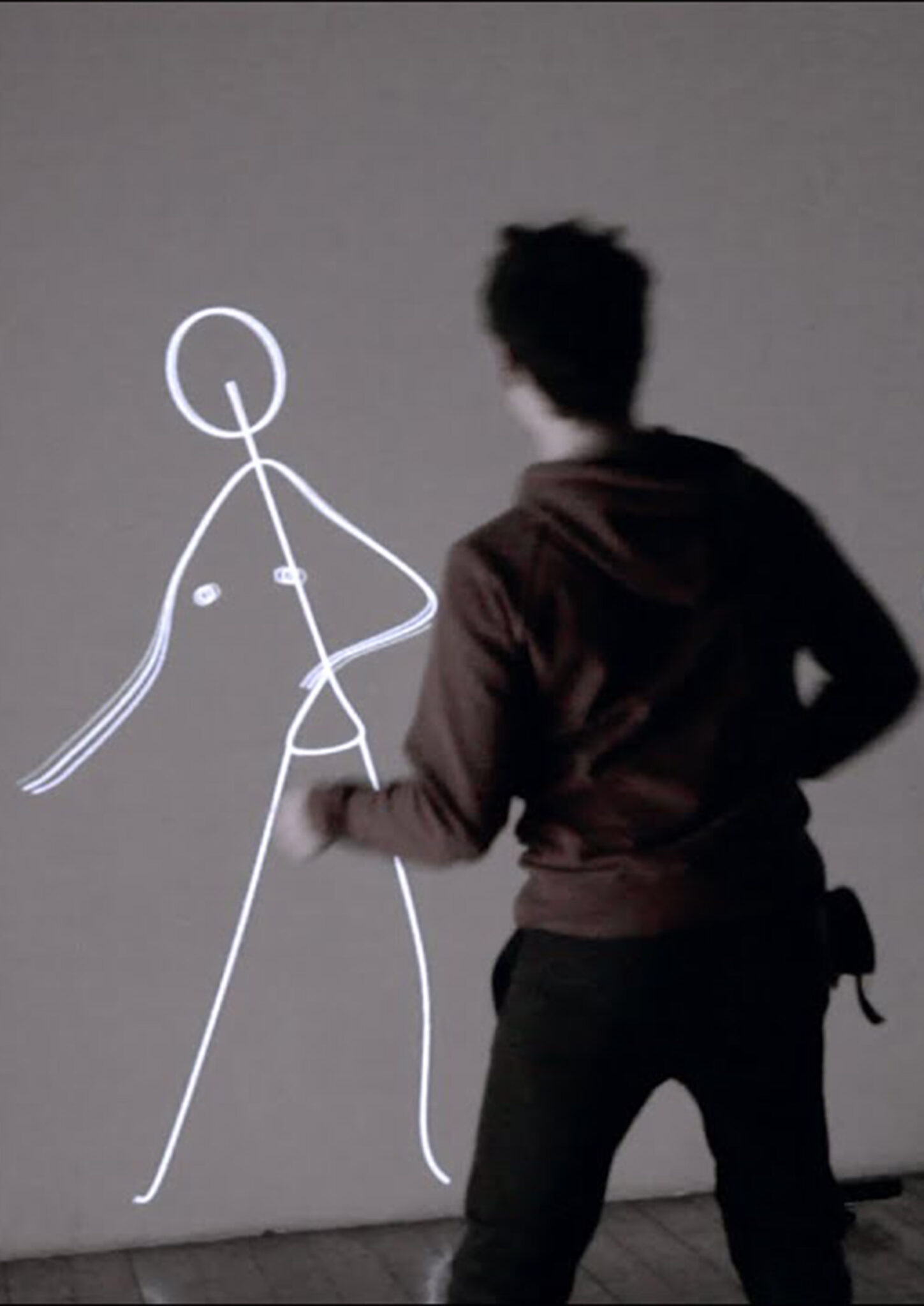
QUBIT AI: Klaus Obermaier, Stefano D’Alessio & Martina Menegon
EGO
FILE 2024 | Installations
International Electronic Language Festival
The mirror stage in psychology explains how the Ego forms through objectification, where one’s visual appearance comes into conflict with emotional experience, a concept called ‘alienation‘ by psychoanalyst Jacques Lacan. The interactive installation EGO reenacts and reverses this process by distorting the mirror image based on the user’s movements, highlighting the tension between the real and the symbolic, the Ego and the It, subject and object.
Bio
Klaus Obermaier is an interdisciplinary artist, director and composer who creates innovative works in the performing arts, music and installations using new media. Stefano D’Alessio researches social issues induced by the internet and explores how the web and its derivatives influence human behavior and the body. Martina Menegon creates intricate assemblages of physical and virtual elements, exploring the contemporary self and its hybrid corporeality.

QUBIT AI: Infratonal
Useless Hands
FILE 2024 | Aesthetic Synthetics
International Electronic Language Festival
Infratonal – Useless Hands – France
When our hands become useless, what will we choose to do with them? We can use AI to visualize the unthinkable, the strangely familiar yet indescribable forms and structures. Generative AI could be used as an amplifier of our ability to explore abstraction and surrealism rather than a simple mirror of our usual perceptions.
Bio
Infratonal is an artistic project led by Louk Amidou, a Paris-based multidisciplinary artist who works at the intersection of digital arts, electronic music and interaction design. He uses algorithms to create hybrid visual and sound pieces which aim to be performed by the human gesture as intangible instruments. He questions the artwork’s nature at the age of AI and the relationship between the artist and the algorithm.

Clara Daguin
Oracle Collection
The performance centered around ORACLE, a digital palm reading given by model and iconic muse Axelle Doué. The surrounding luminous dresses embodying the four elements— air, earth, water, and fire—come alive during the reading, with mirrors reflecting them into infinity. The pieces are crafted from diverse materials, both natural and synthetic. Well beyond typical textiles, Clara Daguin implements optical fibers, pleating, embroidered circuits, addressable LEDs, sculpted resin, home-grown alum stone crystals, Swarovski Elements, silk organza, microcontrollers and radio frequency modules.

Olafur Eliasson
DET LYTTENDE SPEJL
Visitors to DNV-Gødstrup, a new hospital near Herning, Denmark, are greeted at the main entrance by an airy, round pavilion. Two curved pipes, crossing one another perpendicularly, hold a large disc aloft at a slight angle. The reflective underside of the disc mirrors the semicircular pipes, creating the illusion of two complete circles passing through the ceiling and rising into an imaginary space above. As visitors enter the pavilion, they can gaze up at their own reflections in the mirror and see themselves incorporated, upside down, into the artwork, embraced within the globe drawn by the pipes. The tilt of the ceiling allows the reflections to be seen from the outside. As the viewer moves towards and around the pavilion, the rings appear to shift in shape, changing from ellipses to circles and back again.

HUANG YI & KUKA
The work fulfills Huang’s childhood dream of having a robot dance partner and required development from scratch. After learning the mechanics of the industrial KUKA robot, he conceptualized the movements and programmed the machine to create the partner he wanted. He says of the experience, “Dancing face to face with a robot is like looking at my own face in a mirror… I think I have found the key to spin human emotions into robots.” It was developed into a full-length piece with two additional dancers as part of 3-Legged Dog Art & Technology Center‘s Artist Residency program and their 3LD/3D+ program.

bohyun yoon
БОХЬЮН ЮН
윤보현
To Reverse Yourself
My work poses the question: how does reality becomes exquisitely animated by certain social control systems such as politics, mass media, technology, science, and etc. It is my artistic goal to reveal how human beings are fragile and delicate in these social environments. By living in Korea, Japan and the U.S, I have first-hand experience in diverse social systems and have come to view my life experiences as raw material for my research. With my research in mind, my art utilizes the body as the tool for an intensive investigation of the public and private; examining the relationship between how people understand their body and how this understanding represents themselves in the greater context.
Currently, I am curious about human perception developing parallel with the ever-evolving progression of technological world. Thus, I question technology’s relationship to reality and illusion; asking what is reality? My work takes advantage of illusion to explore and answer this question, and often my artistic materials consist of the body and mirrors. I use mirrors for integrating reality and illusion.

SpY
ORB
The shape of the piece alludes to the ‘pi’ number concealed in the geometry of the Pyramids, found when dividing the perimeter of a Pyramid by twice its height. The sphere is an invisible part of the resulting geometry, since a sphere with a radius as high as the Pyramid would have a circumference very close in length to the Pyramid’s perimeter. The surface of the artwork captures the Pyramids, the sky, the surroundings and the viewers in a multiple fragmented reflection. It references the role of the circular mirror in historical Egyptian symbolism, where it was linked to the sun and conveyed notions of creation and rebirth.

terry gilliam
The Imaginarium of Doctor Parnassus
The Imaginarium of Doctor Parnassus is a 2009 fantasy film directed by Terry Gilliam and written by Gilliam and Charles McKeown. The film follows a travelling theatre troupe whose leader, having made a bet with the Devil, takes audience members through a magical mirror to explore their imaginations and present them with a choice between self-fulfilling enlightenment or gratifying ignorance.
cinema full

Wayne Mcgregor
Torus
Directed by British fashion photographer Nick Knight of SHOWStudio, Torus is a film on human connection and loneliness featuring choreography by Wayne McGregor and styling by Norwegian designer Fredik Tjærandsen. Performed by Company Wayne McGregor, Torus shows dancers wearing inflatable balloons designed by Tjærandsen, orbiting in darkness as isolated entities, occasionally lit as they transition through a temporal universe, a mirror to the life that many are only passing through, barely connecting.

Kaito Sakuma
Ether – liquid Mirror
Между вами и мной есть «что-то».
Это зеркало вибрирует и само звучит (как динамик). Биение сердца и звук воды синхронизируются с частотой пульса посетителей и взаимодействуют друг с другом. Система обратной связи будет отдыхать каждые 20 минут. Эта программа направлена на то, чтобы дать «успокоение и пробуждение». В это время covid-19 мы теряем доверие к воздуху. «Эфир» будет напоминать посетителям о существовании чего-то невидимого между всем огромной волной сжатия и синхронизированным с ними искаженным изображением.

Playmodes Studio
“Espills” is a solid light dynamic sculpture. Built using laser beams, laser scanners and robotic mirrors, it is inspired by crystalline formations. A set of geometric figures that float in the air and which suggest, in an abstract way, the transmutation of matter from chaos to order. Dust becoming crystal, being eroded and becoming sand again.

Daniel Rozin
Darwinian Rotating Lines Mirror
Questo è il terzo pezzo della serie di Darwinian Software Mirrors. In queste opere la “pressione evolutiva” programmata spinge le opere d’arte ad assomigliare all’immagine speculare dello spettatore. Coinvolgendo lo spettatore con una risposta interattiva, ogni opera varia le proprietà formali di linea, luminosità e tempo, poiché le immagini basate sullo schermo sono costruite in modo improvvisato.

Oli Sorenson
Video Pistoletto
FILE-FESTIVAL
The latest of Oli Sorenson’s remix series is directly inspired by Michelangelo Pistoletto’s (1933) celebrated shattering of large mirrors.

Jacqueline Hen
Light High
The installation LIGHT HIGH is aimed at guiding the perception through targeted acoustic and visual phenomena into border areas in which ambivalent experiences set in and the habitual experience of space is abolished.[…] A mirrored ceiling together with a thin reflecting surface of water on the ground and a grid arrangement of lights are creating the spatial illusion of an infinite vertical space of light and darkness. By traversing a small bridge, the visitor can cautiously discover the immersing endlessness beneath his/her feats and above his/her head.

Kenny Wong
Squint
file festival
I was inspired by how the sunlight bounces around in our artificial forest.
“Squint” is a kinetic light installation consisting of 49 mirrors that reflect lights in a bright space. The mirrors track and reflect lights on audiences’ face with composed patterns of movements. It extends the generated perception by focusing on how lights pass across our visual senses physically, and combines with our perception of images through flickering. “Squint”, which extracts various daily experiences to an abstraction brings the audience to expand their interpretation of lights and perceived imagination into a non-linear experience.
“Squint” simulates light source and intentionally shines lights on audience’s faces. Bright light is projected in the gallery, a clean bright space.
Everyday people are dynamically moving around in the city. Sunlight reflects and flickers even when it is indirect and hidden behind the artifacts. While we are traveling, we are experiencing motion. We are also experiencing the shift of light intensity, visual patterns and textures. The varieties of light forms inspire the artist to explore the potential of light textures, select and sort out the combined complexity in urban space. The artist turns them into a minimal form of light experience, while maximizing its diversity of perception.
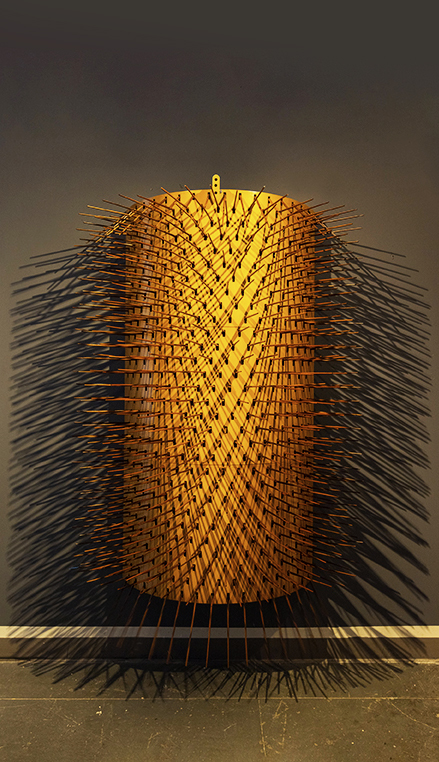
Daniel Rozin
Take Out – Chopsticks Mirror
“Take Out – Chopsticks Mirror” verwandelt ein vertrautes Essgeschirr in ein Porträtelement. Obwohl das Kunstwerk von Natur aus mechanisch ist, versucht es, ein Porträt des Betrachters zu reflektieren, indem es die Fluidität seiner Bewegung widerspiegelt. Das resultierende Porträt ist ein interaktives Bild, das Rozin untersucht durch den Zwang eindimensionaler linearer Objekte. Dieses Stück fungiert als Experiment mit Interaktion jenseits der Reflexion und lädt zu Reaktionen des Stücks selbst (Gesten der Freundlichkeit, Erschrockenheit, Zurückhaltung) sowie generativer Routinen ein 480 Essstäbchen Drumming sind in Zusammenarbeit mit der Komponistin Tamar Muskal arrangiert.

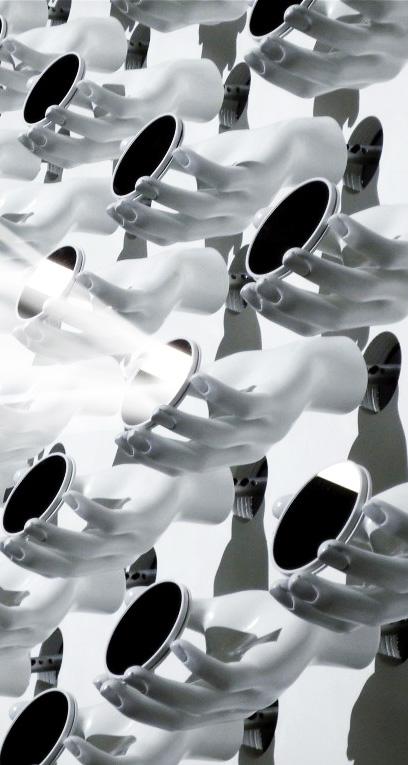
ART+COM
IN MEMORIAM
Joachim Sauter
1959-2021
R.I.P
ART+COM Studios
MOBILITY
THE INSTALLATION SPANS A CORRIDOR OF 7-METRES WIDTH. ON THE LEFT WALL ONE HUNDRED PROSTHETIC HANDS ARRANGED IN A MATRIX REVOLVE AROUND THEIR OWN VERTICAL AXIS, THE MOVEMENTS BEING CONTROLLED BY MOTORS. THE MIRRORS THEY HOLD REFLECT THE BEAM OF A STRONG LIGHT ACROSS THE SPACE AND ONTO THE OPPOSITE WALL. WHAT INITIALLY SEEMS LIKE AN ASYNCHRONOUS, CHAOTIC PATTERN OF MOVEMENT SOON REVEALS ITSELF AS A COMPLEX, COMPUTATIONAL
.
流动性
该安装跨越了7米宽的走廊。在左墙上,排列成矩阵的一百个假肢手绕其自身的垂直轴旋转,其运动由电动机控制。他们持有的镜子将强光光束反射穿过整个空间并射向对面的墙壁。最初看起来像是一个异步的,混乱的运动模式,很快就显示出一种复杂的计算编排:首先,一百个光点围绕一个中心点移动,类似于行星的天体动力学或昆虫群的飞行模式。并创造出三维空间的印象。然后突然之间,这种有机振动会聚成一个表示运动和动作的汉字。

Daniel Rozin
CMY Shadows Mirror
“CMY Shadows Mirror” es un espejo interactivo escultural capaz de reproducir reflejos a todo color. Como la inversa del “RGB Peg Mirror” de Rozin (2020), esta pieza utiliza un modelo de color sustractivo para enmascarar la luz que normalmente se reflejaría, lo que da lugar a una imagen similar a un monitor de computadora o TV. “CMY Shadows Mirror” tiene dos modos de operación: un período interactivo donde el espectador se refleja y una función generativa donde la pieza se anima según varios algoritmos para mostrar una exhibición brillante de colores vibrantes y ondulantes.

Tigre Lab
Mixed Mirrors
Mixed Mirrors es una instalación para crear un lugar para reunirse y pasar un buen rato con un grupo de personas que funcionan como un todo para crear una identidad. Especialmente en estos años, la mayoría de nuestras interacciones son puramente digitales y frías en la distancia. Por eso, queríamos crear un espacio que, explotando estos mismos recursos digitales, quiera crear una conexión más física y real. Un foco, una chimenea, un faro que ilumina y atrae a personas que no se conocen que pueden interactuar reflejando sus rostros en un espejo que fusionará todos los rostros en uno.

Doug Aitken
Sonic Mountain
As a unique site-specific commission for the Donum Estate, Los Angeles-based artist Doug Aitken has created the ethereal work Sonic Mountain (Sonoma), three concentric circles of suspended stainless-steel pipes whose differing lengths form a wave at their base, mirroring the free Euler-Bernoulli shape that describes the chime’s frequency. Installed in the eucalyptus grove, measuring forty-five feet in diameter and twice human height, and comprising 365 chimes — one for each day of the year — Sonic Mountain (Sonoma) works with one of Donum’s most persistent elements, the Carneros breeze that cools the grapes and creates a temperate zone for growing Pinot Noir. Each day, the warm wind begins its soft whisper, rustling through the vines and trees, building in strength through the day until mid-afternoon, and then gradually diminishing in force. Known to have been used since at least the ancient Roman period in Europe and the second century in India and China, wind chimes create chance, inharmonic music. At Donum, Aitken has teamed up with his friend the composer Terry Riley to compose chords in the chimes to be played by the wind , depending on how it blows, so the lyrical work sounds throughout the estate, demonstrating the artist’s practice of making installations that synthesize many media and are never constrained by tradition.
video

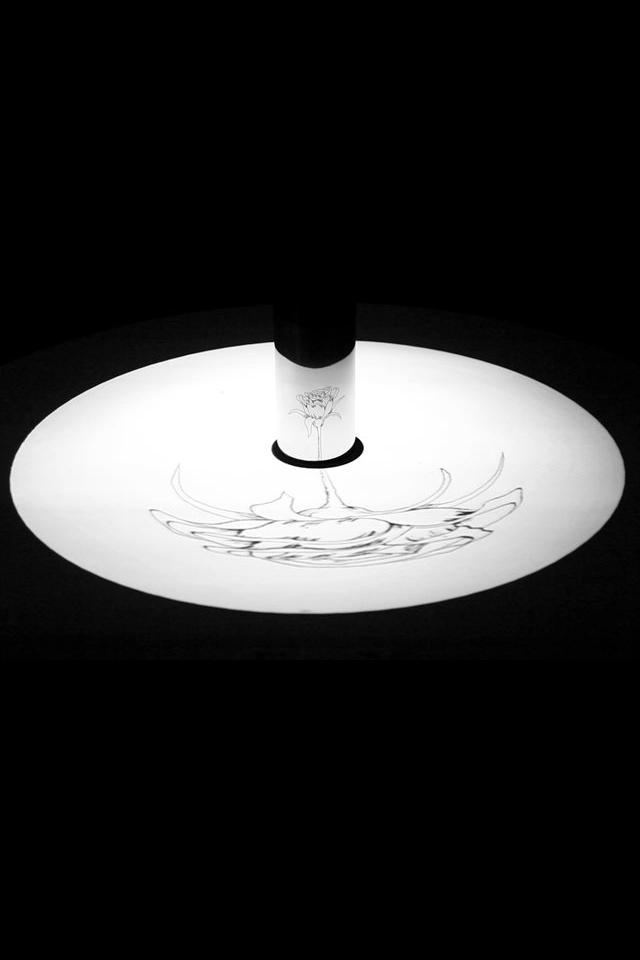
Kanlun Cen
岑侃倫
The Undercurrent
file festival
In the installation, the distorted image projected on the tabletop is reflected in the cylindrical mirror. While one sequence is distorted and reminiscent of a dreamlike state or the hazy inner workings of the mind, the other is clear and in proportion, which enables us to decipher the anamorphic image, thus to confront the “undercurrent” in our mind.

Bohyun Yoon
Mirror Armor
Being entrapped in narcissism is like a “self-jail”. Placing the mirror armor fixtures over my nude body causes the viewer to see the pixelated and fragmented image of myself. Usually covering, hiding, pretending to be a version of myself on the outside, therefore, “good looking” seems more of decoration or in itself a type of armor suitable for public viewing. Will these mirrors of self reflection cause me to wonder who I am on a deeper level? To discover who I truly am, what I am afraid of, why I waste my life without discovering my inner self. I constantly struggle with how I can break this boundary because I want to wake from this oblivion.

clement valla
Valla claimed to have collected a series of 60 “surrealistic” images, or that, at least, give that impression, during a long period “playing” in Google Earth.“The images are a kind of mirrors for a fun house.They are strange illusions and reflections of the real ”Despite the strong distortions, which easily resemble a surrealist painting, the images of the work do not have any manipulation of tools like Photoshop, for example.”The images are screenshots of Earth with basic color adjustments”, “This is a construction of 3D maps on two-dimensional bases, creating these fabulous and unintended distortions”.

RANDOM INTERNATIONAL
随机国际
future self
‘future self’ is a study in human movement. the installation captures movement in light to create a three dimensional ‘living sculpture’ based on the composite gestures surrounding it, mirroring the actions of those who pass around it. entirely hand-made, 30,000 LED lights line the brass rods which are arranged to create a structure reminiscent of a rectangular prism, 3D cameras record people’s motions which are expressed through a ghostly, illuminated image, constantly changing.

FREDRIK SKÅTAR
vibration mirror
Его художественные проекты следуют морфогенетической концепции – биологическому процессу, который заставляет структуру развивать свою форму. В природе форма создается постоянно меняющейся окружающей средой и приспосабливается к ней. Капля – это источник колец на поверхности воды, межзвездные силы – это параметры, которые определяют положение звезд и так далее. Изображения и скульптуры Фредрика Скатара представляют собой моментальные снимки таких процессов, визуализирующие параметры и происхождение конкретных структур. Архитектура Фредрика Скатара, как и художественные проекты, сосредоточена на подчеркивании цели и происхождения пространственных компонентов. Они, встроенные в систему использования, обладают противоположными свойствами, которые подчеркиваются своими противоположностями. Круглые формы дополняются прямыми, порядок поддерживается хаотичной структурой и т. Д.

Milo Moiré
MIRROR BOX
Milo Moiré’s Performance Mirror Box ist eine gesellschaftliche Reflexion der menschlichen Sexualität. Es ist ein erweitertes Reenactment des Tapp- und Tastkinos (1968) und eine Hommage an die aussergewöhnliche Künstlerin VALIE EXPORT, die mit ihren Kunstaktionen bereits in den 1960er Jahren für die Frauenrechte eintrat. Künstlerin Milo Moiré setzt ihren Körper als Instrument, gar als Waffe ein um Machtstrukturen darzustellen und aufzubrechen. Offensiv sucht sie nach dem weiblichen Ausdruck sexueller Selbstbestimmung und lotet die Grenzen der Kunst und der bürgerlichen Moral aus.

Ryoichi Kurokawa
s.asmbli[wall]
Get immersed by 360° projections on a gigantic cube at OCT Loft Creative Festival and surround yourself with the power of nature. Thanks to a well-chosen combination of front and rear projection screens, you can enjoy the immersive fabric projections from every possible angle. To enhance the immersive 360-feel, several mirrors were placed around the eye-catching sculpture, reflecting the high-quality video mapping beautifully.
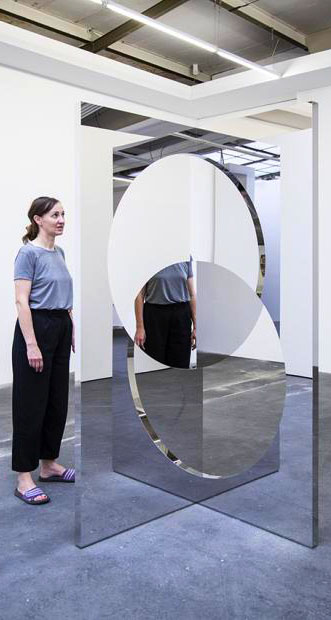
Jeppe Hein
Geometric mirrors
Geometric Mirrors is a series of mirror angles, each comprised of two mirror surfaces intersecting at a 90° angle. While a perpendicular viewpoint simply reflects the viewer and the opposite space, an interesting visual phenomenon occurs when the viewer faces the corner angle directly. The right angle causes a duplicate reflection, as both mirrors reflect not only the space but also each other. Their widths become extended into the adjoining side, thus appearing to the viewer as a mirrored cross rather than a mirrored angle.

Jeppe Hein
Path of silence
Inspired by the remarkable topography of the landscape of the Kistefos Sculpture Park, the stepped slope and terraces beside the Industry Museum, where the power and energy of water is directly visible and gives the site a special quality, a free form is adapted to the shape of this landscape, thus creating a dialogue between the place and the object. The sculpture is defined by an extensive mirror labyrinth that encloses three spaces of silence: A contemplative space, where an enclosure of high mirror steles promotes an upward glance to the sky, a natural space, where a tree inside the sculpture links the inside with the outside and an active space where walls of water appear and disappear, thus offering ever-changing perspectives of the surroundings.

LEANDRO ERLICH
Dalston House
Located in Hackney, Dalston House by Leandro Erlich is a temporary installation comprising a reconstructed house facade lying face-up and a mirror positioned over it at a 45-degree angle. As a person walks over the surface of the house, the mirror reflects their image and creates the illusion that they are walking up the walls. Similarly, visitors can make it look like they are balancing over the cornices or dangling from the windows.
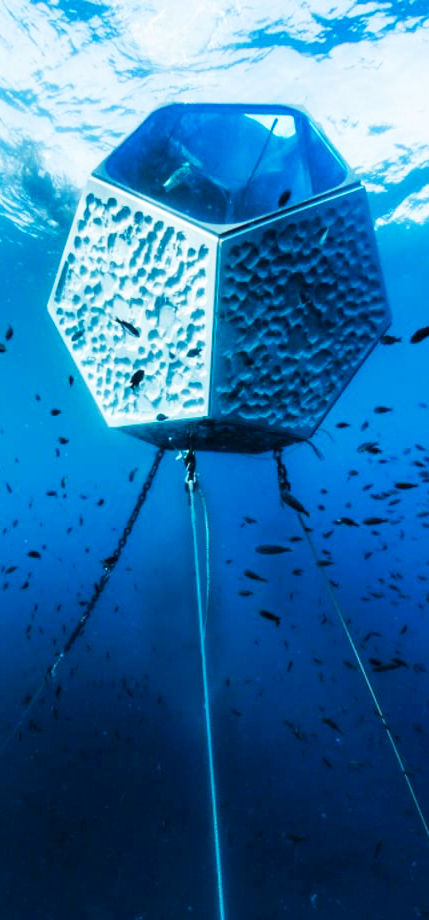
DOUG AITKEN
Underwater Pavilions
Underwater Pavilions is artist Doug Aitken’s large-scale installation produced by Parley for the Oceans and presented in partnership with The Museum of Contemporary Art, Los Angeles (MOCA). The work consists of three temporary underwater sculptures, floating beneath the ocean’s surface that swimmers, snorkelers, and scuba divers swim through and experience. Geometric in design, the sculptures create underwater spaces synthesizing art and science as they are constructed with carefully researched materials and will be moored to the ocean floor. Part of each structure is mirrored to reflect the underwater seascape and create a kaleidoscopic observatory for the viewer, while other surfaces are rough and rock-like. The environments created by the sculptures will constantly change with the currents and the time of day, focusing the attention of the viewer on the rhythm of the ocean and its life cycles.

EMILIJA ŠKARNULYTĖ
Spiegelsache
In dem in Mirror Matter gerenderten Neutrino-Observatorium vermittelt eine langsame Schwenkbewegung ein Gefühl für die Unermesslichkeit der fast 13.000 Fotovervielfacher, die in diesem seltsamen Schiff leben – ihre “Augen“ sind so konstruiert, dass sie Licht beobachten. Ein anderer Rahmen zeigt den Hadron Collider am CERN; Die Architektur wurde durch Lidar-Scans ins Auge gefasst und erzeugt einen dynamischen, transparenten Abdruck in drei Dimensionen. Als eine Vision beschrieben, die durch den Körper fließt, wird sie von Škarnulytė als “fremde archäologische Vision” mit der Fähigkeit zum Durchschauen und als die Erfahrung des Sehens vorgestellt, die am weitesten vom menschlichen Bereich entfernt ist. Durch gleichzeitige Perspektiven, die ständige Vermessungsbewegung, die einen kontinuierlichen Faden durch jede Videoerzählung zieht, und das Eintauchen durch die reflektierende schwarze Decke wird dem Betrachter diese panoptische Wahrnehmungsart vermittelt.

Kimchi and Chips
Difference and Repetition
The title references Deleuze’s thesis ‘Difference and Repetition’ – his attempt to understand reality without referring to identities. The artists aim to ‘unidentify’ the audience – to criticize the bubbles of reality which technology has helped us to build around ourselves. By allowing ourselves to remove our identity occasionally, we can better understand the thoughts of those we disagree with and therefore better work together to build a combined reality. Difference (in both senses) is generated by the motion control system which continuously changes the pose of the mirrors relative to the viewer. This movement disrupts space itself, creating a transformation similar to that of a Lorentz transformation when one travels close to the speed of light. This causes space itself to compress, twist and break, giving the viewer a tool for observing the non-absolute nature of time.

Daniel Rozin
Troll Mirror
The mechanical mirrors are made of various materials but share the same behavior and interaction; any person standing in front of one of these pieces is instantly reflected on its surface. The mechanical mirrors all have video cameras, motors and computers on board and produce a soothing sound as the viewer interacts with them. Troll Mirror was commisioned by Traget and is made of pairs of pink and blue troll dolls. Every troll doll pair can rotate so that the pink or blue troll face the front. The result is a colorfull reflection of the viewer’s outline and playfull colorfull transitions

Maria Svarbova
Grössling City Bath
Maria’s photographic work is both non-sentimental and emotionally powerful at the same time. In one of her latest projects, the photographer has produced a range of portraits in the Grössling City Bath. The images are characterized by some kind of mirrored symmetry of unspoken tension.
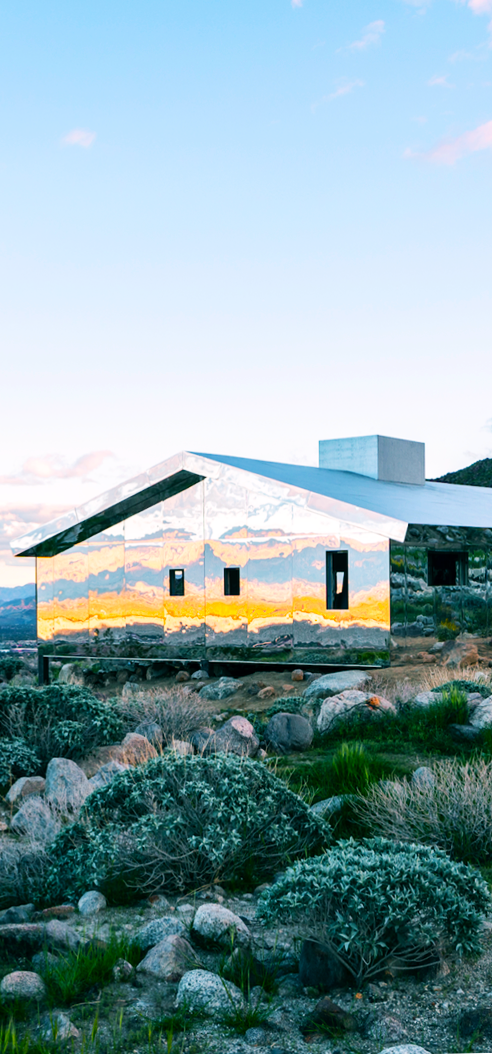
Doug Aitken
Mirage Gstaad
“Mirage Gstaad by Doug Aitken uses the frequency of light to reflect the sublime Alpine landscape as part of a continually changing encounter in which land and sky, subject and object, inside and outside are in constant flux. Standing in contrast to the surrounding chalet’s the ranch-style structure suggests a latter-day architectural version of Manifest Destiny, the westward migration that began in Europe and finally settled in California. With every available surface clad in mirror it both absorbs and reflects the landscape around in such ways that the exterior will seemingly disappear just as the interior draws the viewer into a never-ending kaleidoscope of light and reflection.

Nicolas Bernier
Structures infinies
Between the finite and the infinite, these mirror structures are reflecting the outside world until they are set in motion to unveil a moving and infinite interior. Hidden inside are superimposed diagrams reinterpreting certain theories or hypotheses related to our apprehension of the world. Between transcendental geometry, higher dimensions, finite and infinite, these structures arise as objects of reflection on what one understands, what one believes to understand and what one does not understand. The structure is thus referring to the finite physical structure that is encapsulating the infinity of intellectual structures created by the humankind.

Kohei Nawa
Throne
This work attempts to express that premonition as an immense “floating vacant throne”. If instances of power and authority have ruled since ancient times, and the pyramids provide one example—we must ask what the future will hold. Created with reference to the forms of festival floats and portable shrines that appear in the rituals and festivities of the East, the sculpture fuses today’s 3D modeling techniques with gold leaf applications that date back to ancient Egypt. In the frontal center is an empty room, space enough for a 2 to 3-year-old child to sit, suggesting that the new intelligence is still in a young state. Shining, spherical mirrors placed at the center in front and back. Made of platinum foil, they represent “the eyes overlooking the world”, where the frontal one faces the future and the back reflects into the past.

Phillip K Smith
Open Sky
Using giant sheets of mirror-polish stainless steel, Smith’s structure reflects the ever-changing sky. He describes that ‘Open Sky’ is “inspired by the constant shifts in light, color, and form that are presented in the natural and built environment.” The piece is designed to get visitors at the design week to interact with the natural environment and to spark a sense of adventure.

Lucid Creates
Futures
Futures uses the optical illusions created by light, sound and mirrors to transport audiences to a place where good things have happened and the future we want exists now. Futures is an immersive space in which audiences experience illusions that can reveal everything from how they process space and time to their perception of consciousness. It is a modular light installation that takes a number of forms. It is shown here as a walkway of mirrors and lights, tunnelling inwards towards a vanishing point.

Sally Golding
Your double my double our ghost
The installation acts a space for the consideration of intimacy and meditation– both alone and with others that may share the space – through the merging of the viewer’s own reflections articulated through a composition of shifting light and emerging sounds which fill an otherwise dark chamber. Functioning similarly to the classic funfair mirror– the flexible silver two-way mirror sheeting forming an ethereal hanging centrepiece– the work invites the viewer to consider representations of themselves which appear distorted and transient, and which merge with those around them to form ‘new presences’. In this sense the viewer may see themselves multiplied or doubled with another viewer, or find themselves alone in a rare moment of literal reflection providing a contemplative space or eliciting a hallucinatory fantasy bringing forth ideas in neuroscience around the Self and Other.

EMILIJA ŠKARNULYTĖ
Mirror Matter
In the neutrino observatory rendered in Mirror Matter, slow panning movement gives a sense of the immensity of the nearly 13,000 photo-multipliers that inhabit this strange vessel – their ‘eyes’ engineered to watch light. Another frame depicts the Hadron Collider at CERN; its architecture envisioned through lidar scans, producing a dynamic, transparent imprint in three dimensions. Described as a vision that flows through the body, it is imagined by Škarnulytė as ‘alien archaeological vision’ with the ability to see through, and as the experience of sight farthest from the human realm. Through simultaneous perspectives, the constant surveying motion that weaves a continues thread through each video narrative, and the immersion generated by the reflective black ceiling, the viewer is imparted with this panoptical mode of perception.

Datapaulette
Topographie digitale
“Topographie Digitale” is an interactive installation created by DataPaulette. This landscape uses electrically functionalized and pleated textiles as sensitive surfaces reacting to touch. This interaction brings to life a “digital clone”, video-projected. This mirrored scene reveals an organic side contrasting with the mineral aspect of the physical scene.

SARAH OPPENHEIMER
사라 오펜하이머
D-33
NYC-based artist Sarah Oppenheimer‘s work blurs the line between sculpture and architecture. Her amazing installations usually involve moving walls, slanting floors, and creating apertures—sometimes symmetric, sometimes asymmetric, and often with mirrors—that would mesmerize (and confuse) the most resistant of gallery/museum guests.

Arnaud Lapierre
Azymut
AZYMUT offers a defragmented and detailed look at the architectural elements and pieces of sky that surround it. A rotating installation of 16 magnifying mirror discs, motorized and synchronized, slowly directs the visitor’s gaze to disjointed elements of the Riva degli Schiavoni and the Palazzo Ducale opposite to the Church of San Giorgio Maggiore.

